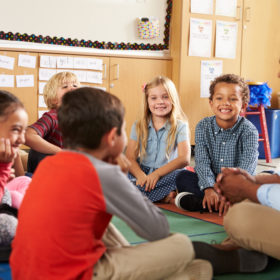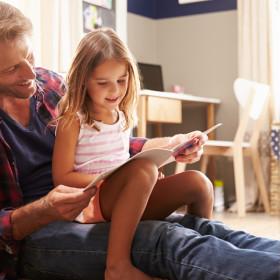Tips & Activities To Improve Your Child’s Active Listening Skills

Listening is an important component of learning. A student’s ability to actively listen has a major impact on building the communication skills needed both inside and outside of the classroom.
Active listening is an important “soft skill”, like problem-solving, leadership, and teamwork. It’s a skill that can be acquired and developed — but it takes time and patience to master!
WHAT IS ACTIVE LISTENING?
Active listening means giving full attention to the speaker and trying to understand the complete message being sent. Active listeners show verbal and nonverbal signs of listening. Positive reinforcement, remembering, and questioning are all verbal signs of active listening. Non verbal signs include smiling, head nods, posture, and avoiding all distractions.
Active listening also involves encouraging positive conversation. This means acknowledging the other person’s point of view and being able to repeat back what was said in your own words.
WHY IS ACTIVE LISTENING IMPORTANT?
Having active listening skills has many benefits; besides better comprehension in the classroom, active listeners tend to be better communicators and problem solvers. Being an active listener also shows good character, commitment, and is an essential component of being a leader.
Benefits of being an active listener include:
- Fewer misunderstandings
- Faster work rate
- Improved resourcefulness
- More self-reliance
- Improved productivity
ACTIVE LISTENING VS PASSIVE LISTENING
So, what happens if you aren’t actively listening? You may fall into the trap of passive listening. Passive listening is simply hearing what the speaker is saying without really trying to understand it. When students passively listen, they don’t retain information because they are easily distracted.
Active listening requires the listener to understand the point the speaker is trying to communicate, not just hearing the words he or she is saying.
Becoming a better listener is an important skill that students need to actively develop and practice.
How can you help your child improve his or her listening skills?
FIVE STEPS TO ACTIVE LISTENING
Parents and teachers can teach students how to become an active listener by becoming active listeners themselves. Through modelling active listening to your child, he or she is able to see the value and importance of being an active listener. It also gives your child a reference to develop his or her own listening habits.
Improve the active listening skills of both you and your child by following these 5 tips:
-
Maintain eye contact
-
Don’t interrupt
-
Ask questions
-
Repeat back what the speaker says
-
Listen for total meaning
People who maintain eye contact are seen as reliable, warm, sociable, honest, confident, and active. Focusing your eyes also helps improve concentration. This helps you fully understand what the speaker is saying.
Let the speaker complete his or her thought before you try to respond. Do not interrupt, finish sentences, or rush him or her. Avoid guessing or assuming where his or her thoughts are going— this can create a negative impact on effective communication.
One way to show you are listening (and make sure you hear correctly) is to ask specific questions about what is being said. This provides clarification, ensures understanding, and shows that you are listening.
Try asking these four types of questions:
Open-ended: expand the discussion further
Example: “How was your day at school today?”
Close-ended: prompt for specifics
Example: “Are you finished your homework?”
Leading: prompts the respondent to answer in a particular way
Example: “Do you have too much homework?”
Reflective: expand and extend thinking
Example: “You mentioned math is your favourite subject in school, tell me more about that.”
Repeat what has been said back to the speaker in your own words. This helps make sure you have understood what he or she is saying. Summarize by repeating the main points of the message. This gives the speaker a chance to correct you, if necessary.
Any message has two components: the content of the message and the underlying feeling or attitude. Both parts are important and give the message meaning. Listen for both for content and the underlying emotions. Sometimes the real message is in the emotion rather than the content.
By following these tips, you and your child are developing the skills you both need to be better active listeners. Practicing these steps with your child will continue to help him or her improve his or her listening habits.
ACTIVE LISTENING ACTIVITIES FOR STUDENTS
Showing your child how to be an active listener by example is only the first step. It is also important to practice these skills.
Try these activities to help develop and sharpen your child’s listening skills.
- Read stories to your child. Ask him or her to predict what will happen next. The prediction requires your child to listen to the details to make a logical guess.
- Cook with your child. Read the recipe to him or her, having your child listen to and follow each step to complete the recipe correctly.
- Have conversations about things your child is interested in. This gives your child a chance to engage in a real conversation, practicing both speaking and listening.
- Play the telephone game. Get together with a group and have one person whisper a sentence to the next person. Each person repeats it to the next until the final person. Have this person say the sentence aloud and see how much the two sentences have changed.
- Create a list of questions with your child for him or her to ask you or a sibling. After one person has answered, see how many the other can remember. Switch roles and see how well the other person does.
- Play the “spot the change” game. Read your child a short story. Then read it again, making some changes. Each time your child hears a change have him or her clap or raise his or her hand.
- Get creative with “follow the directions.” Give short, simple instructions and have your child draw according to the directions they hear.
It takes a lot of concentration and determination to be a better listener. Practicing active listening techniques will help students become better communicators and build listening skills they will use for life.
Looking for some extra help? Find out more about Oxford Learning’s programs and how we can help students reach their full potential.




